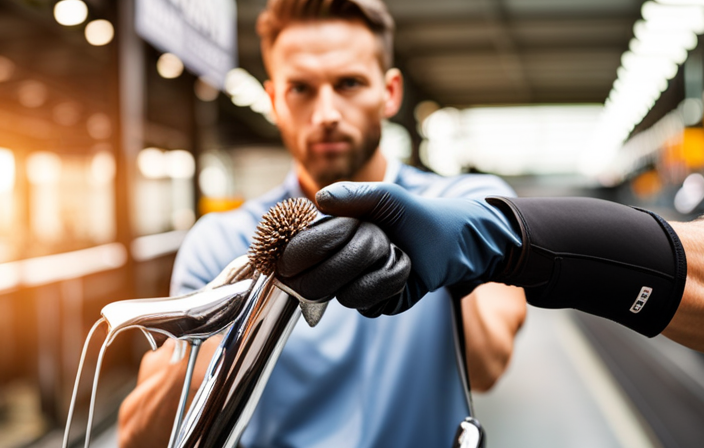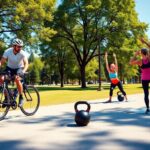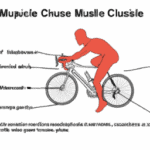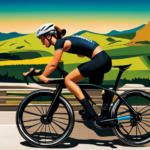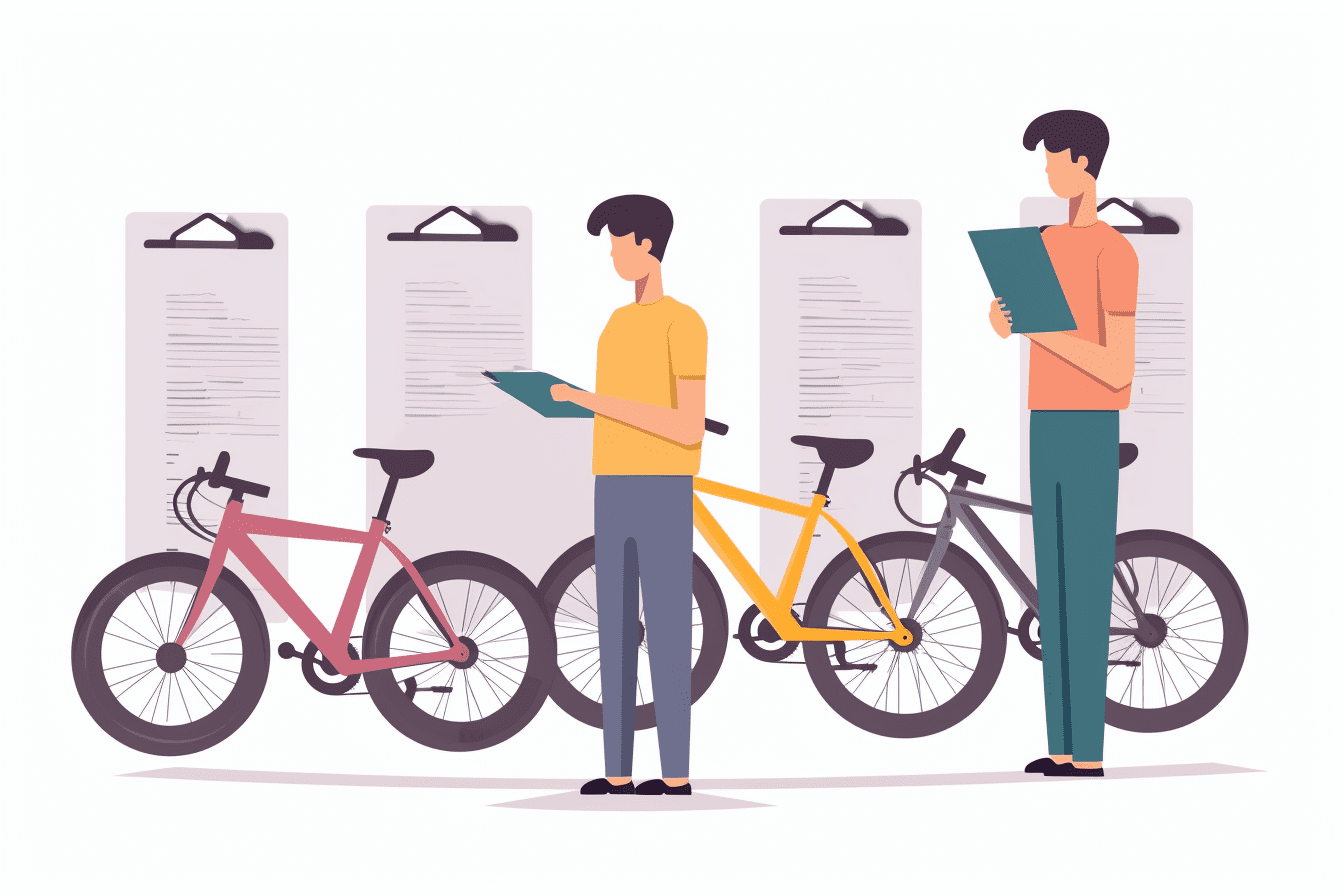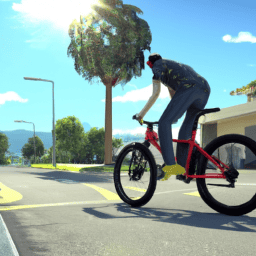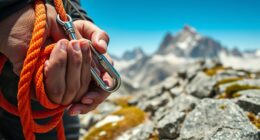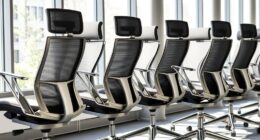Prepare to outpace your competitors as we explore ways to speed up your bike.
In this article, I will guide you through a series of technical and knowledgeable steps to transform your bike into a speed machine.
From upgrading your components to optimizing your aerodynamics, we will explore every aspect of making your ride lightning fast.
So, buckle up and get ready to pedal your way to victory.
Key Takeaways
- Incorporate strength training exercises like squats, lunges, calf raises, bench press, and deadlifts to improve cycling performance.
- Engage in cross training activities such as swimming, running, rowing, HIIT, and circuit training to enhance cycling performance.
- Utilize interval training techniques like high-intensity intervals, Tabata intervals, Fartlek training, hill repeats, and pyramid intervals to boost speed and endurance.
- Build endurance through long rides by planning regular longer rides, gradually increasing distance, including hills and varied terrain, maintaining a steady pace, and practicing fueling and hydrating during long rides.
Choose a Lightweight Frame
You’ll want to choose a lightweight frame to make your bicycle faster. A lighter frame reduces wind resistance and allows for improved power transfer, resulting in a more efficient ride.
When selecting a frame, consider materials such as carbon fiber or titanium, which offer high strength-to-weight ratios. These materials are known for their ability to absorb road vibrations, providing a smoother and more comfortable ride.
Additionally, a lightweight frame allows for quicker acceleration and easier maneuverability, which can be crucial in competitive cycling.
To further enhance your bike’s performance, it is important to upgrade your bike components. These upgrades can include upgrading the drivetrain, brakes, and wheels, which will all contribute to a faster and more efficient ride.
Upgrade Your Bike Components
To enhance your cycling speed, consider upgrading the components of your bike. By improving the quality of your bike’s components, you can increase power and enhance bike handling. Upgrading key components such as the drivetrain, brakes, wheels, and tires can have a significant impact on your bike’s performance.
Firstly, upgrading the drivetrain can provide smoother shifting and more efficient power transfer, resulting in increased speed. Upgrading to a lighter and more aerodynamic wheelset can also reduce rolling resistance and improve overall speed. Additionally, upgrading to high-performance tires can enhance grip and cornering ability, allowing for better bike handling. Lastly, upgrading to more advanced braking systems can improve stopping power and control.
By upgrading these components, you can optimize your bike’s performance and maximize your cycling speed. In the next section, we will explore how to optimize your bike fit to further enhance your riding experience.
Optimize Your Bike Fit
Optimizing your bike fit is crucial for improving your cycling experience. A proper bike fitting ensures that your bike is adjusted to fit your body measurements and biomechanics, allowing for efficient power transfer and reducing the risk of injury.
One key aspect of bike fitting is adjusting your bike position. This includes setting the saddle height, fore-aft position, and handlebar reach. Getting these measurements right can make a significant difference in your comfort and performance on the bike. A correct bike position promotes optimal muscle engagement, reduces fatigue, and allows for more efficient pedaling.
Once you have optimized your bike fit, you can move on to the next section, where we will explore how to improve your aerodynamics and further enhance your cycling speed and efficiency.
Improve Your Aerodynamics
Improving your bike’s aerodynamics can greatly enhance your cycling speed and efficiency. To reduce wind resistance, there are several key strategies you can employ:
- Position yourself lower on the bike to minimize your frontal area.
- Opt for aero handlebars that allow you to maintain a more streamlined position.
- Use aero wheels that have fewer spokes and a deeper rim profile.
- Install aero frames and forks that are designed to cut through the air more efficiently.
Additionally, wearing aerodynamic clothing can further reduce drag and increase your speed. Choose form-fitting jerseys and bib shorts that are specifically designed for cycling at high speeds.
By implementing these aerodynamic improvements, you can maximize your cycling performance.
Next, let’s explore the importance of using the right tires to further enhance your bike’s speed and efficiency.
Use the Right Tires
When choosing the right tires, you’ll want to consider factors such as rolling resistance and grip to enhance your cycling speed and efficiency. Tire selection plays a crucial role in determining your performance on different terrains.
For smooth roads and racing, narrow tires with minimal tread patterns are ideal. These tires provide low rolling resistance, allowing you to maintain higher speeds with ease.
On the other hand, for off-road or rough surfaces, wider tires with aggressive tread patterns offer better grip and control. However, it’s important to note that wider tires can increase rolling resistance, which may slightly affect your speed. Therefore, it’s essential to strike a balance between tire width and speed.
With the right tire selection, you can optimize your cycling experience.
Now, let’s move on to maintaining proper tire pressure for optimal performance.
Maintain Proper Tire Pressure
Maintaining proper tire pressure is crucial for optimal performance on your bike. It not only affects your speed but also your overall comfort and control. To increase tire grip, you need to find the right balance between high and low pressure. Using a lower pressure provides better traction and a smoother ride, especially on rough surfaces. However, too low pressure can lead to pinch flats or increased rolling resistance. On the other hand, higher pressure reduces rolling resistance and increases speed, but it sacrifices some grip and comfort. To help you visualize the impact of tire pressure, consider the following table:
| Tire Pressure | Grip | Comfort |
|---|---|---|
| Low | High | High |
| Medium | Medium | Medium |
| High | Low | Low |
Additionally, using tubeless tires can further enhance grip and reduce the risk of punctures. So, by maintaining proper tire pressure and choosing the right tires, you can significantly improve your bike’s performance. Now, let’s transition into the next section about keeping your bike clean and lubricated.
Keep Your Bike Clean and Lubricated
To enhance your biking experience, it’s important to regularly clean and lubricate your bike. By doing so, you can prevent rust and ensure that your bike performs at its best.
Regular maintenance is key to keeping your bike in top condition. Start by cleaning your bike with a mild detergent and water, making sure to remove any dirt or debris. Pay special attention to the chain, gears, and brakes, as these areas are prone to accumulating grime.
After cleaning, apply a lubricant specifically designed for bicycles to the chain, derailleurs, and other moving parts. This will help reduce friction and keep your bike running smoothly.
With a clean and well-lubricated bike, you’ll be ready to practice efficient pedaling techniques, optimizing your performance on the road.
Practice Efficient Pedaling Techniques
Improve your biking efficiency by practicing efficient pedaling techniques. Cadence control is crucial for maximizing your speed and power output on a bicycle. Maintaining a consistent and optimal cadence, or pedal revolutions per minute (RPM), allows for a smoother and more efficient transfer of power from your legs to the pedals.
Aim for a cadence of around 80-100 RPM, which ensures a good balance between speed and force. To achieve this, focus on spinning your pedals in a circular motion rather than mashing down on them. Additionally, pay attention to your body position and posture, keeping your upper body relaxed and your core engaged.
By mastering efficient pedaling techniques, you can optimize power transfer and enhance your overall cycling performance.
Transitioning to the next section, it is important to train and build your cycling fitness to further improve your speed.
Train and Build Your Cycling Fitness
If you want to enhance your cycling performance, it’s essential to train and build your cycling fitness. Here are some key strategies to help you achieve better results:
-
Strength training for cyclists: Incorporate exercises that target your leg muscles, such as squats, lunges, and calf raises, to improve power and endurance on the bike.
-
Cross training for improved cycling performance: Engage in activities like swimming or running to enhance overall cardiovascular fitness and work different muscle groups, promoting a well-rounded fitness level.
-
Interval training: Incorporate high-intensity intervals into your rides to improve speed, endurance, and lactate threshold.
-
Long rides: Plan longer rides to build endurance and improve your ability to sustain effort over extended periods.
By incorporating these training methods into your routine, you can boost your cycling fitness and ultimately increase your speed and performance.
As you continue to work on your training, it’s crucial to also focus on staying hydrated and fueling properly during rides for optimal results.
Stay Hydrated and Fuel Properly During Rides
Ensure that you stay hydrated and fuel properly during your rides to maintain optimal performance.
Proper nutrition and hydration are essential for improving your cycling speed. To fuel your body efficiently, consider these nutrition tips.
First, consume a balanced diet that includes carbohydrates, proteins, and healthy fats. Carbohydrates provide the necessary energy for your rides, while proteins help repair and build muscle tissues. Additionally, healthy fats contribute to overall energy production.
Hydration strategies are equally crucial. Drink water before, during, and after your rides to prevent dehydration. Electrolyte-rich drinks can also replenish essential minerals lost through sweat. Remember to monitor your fluid intake, aiming for at least one bottle per hour of riding.
By following these guidelines, you can optimize your performance and make your bicycle faster.
Frequently Asked Questions
What are some common mistakes to avoid when upgrading bike components?
Some common upgrade mistakes to avoid when improving bike components include choosing incompatible parts, neglecting proper maintenance, and not considering the overall bike setup. It is important to conduct research and consult with experts before making any upgrades.
How do I know if my bike fit is optimal for speed and performance?
To determine if my bike fit is optimal for speed and performance, I must understand the importance of correct bike fit. Making necessary bike fit adjustments will enhance my efficiency, power transfer, aerodynamics, and overall comfort on the bike.
Are there any specific aerodynamic techniques or positions that can make a significant difference?
To make a significant difference in aerodynamics, I recommend using aerodynamic clothing and considering bike frame modifications. These techniques can optimize your position and reduce drag, ultimately improving your speed and performance on the bike.
How do I choose the right tires for improving speed?
When choosing the right tires for improved speed, there are several factors to consider. Tire width is one of them, as wider tires can increase rolling resistance and slow down your bike.
What are some tips for maintaining proper tire pressure for optimal performance?
To ensure optimal performance, it is essential to maintain proper tire pressure. Follow tire pressure recommendations provided by the manufacturer, regularly check and adjust pressure as needed. This ensures efficient cycling experience and minimizes the risk of accidents.
Conclusion
So there you have it, my friends. By following these tips and techniques, you can transform your bicycle into a lightning-fast machine.
Picture yourself gliding effortlessly down the road, the wind whistling in your ears as you conquer each uphill with ease.
Feel the exhilaration as you push your limits and leave your competition in the dust.
With a lightweight frame, upgraded components, optimized fit, improved aerodynamics, the right tires, and proper maintenance, you’ll be unstoppable.
Pedal with precision, train hard, stay hydrated, and fuel your body for success.
Now go out there and ride like the wind!

